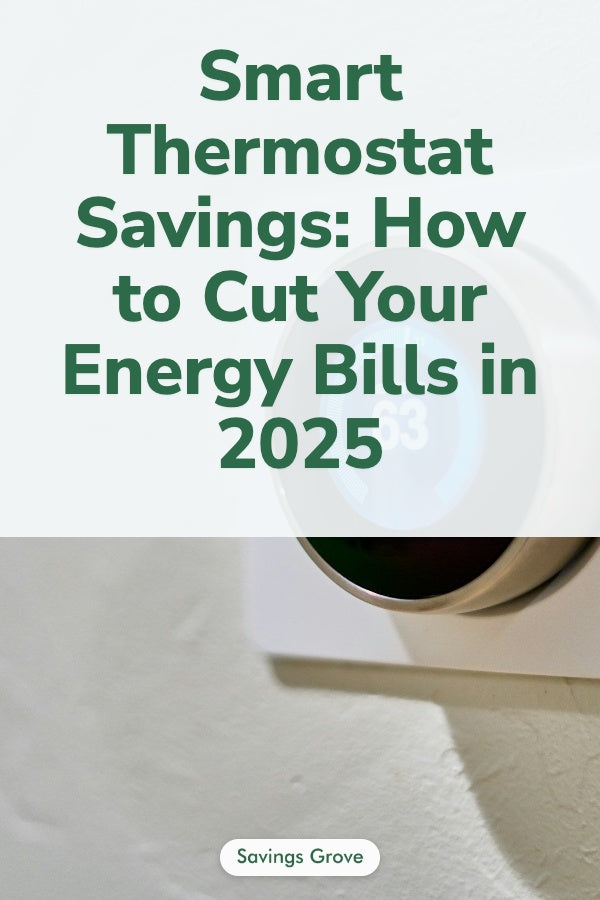
In 2025, smart thermostats have become one of the most effective ways to reduce energy costs while maintaining comfort in your home.
Smart Thermostat Savings: How to Cut Your Energy Bills in 2025
With rising utility costs, these intelligent devices can help you save between $50 to $120 annually on your heating and cooling bills. Here's everything you need to know about maximizing your savings with a smart thermostat. We recommend the following products for cutting your energy bill today:
1. Ecobee Smart Thermostat Premium
The Ecobee Smart Thermostat Premium offers the highest potential savings, with users reporting 26% average reductions in energy costs. At $249.99, it features room sensors, smart home integration, and an air quality monitor. The device pays for itself within 2 years through energy savings.
2. Google Nest Learning Thermostat
Google's flagship smart thermostat learns your schedule automatically and adjusts temperatures accordingly. Priced at $199+, it can reduce heating and cooling costs by up to 15%. The device includes features like remote control via smartphone and energy history reports.
3. Amazon Smart Thermostat
The most budget-friendly option at $59.99, Amazon's Smart Thermostat works with Alexa and offers basic smart features. While simpler than premium models, it still provides estimated savings of 10-15% on heating and cooling bills.
4. Emporia Smart Thermostat
The Emporia Vue Smart Thermostat, priced at $129.99+, stands out for its energy monitoring capabilities. It connects with the Emporia energy monitoring system to provide detailed insights into HVAC energy usage. Users report average savings of 15-20% on heating and cooling costs.
5. Honeywell Home T9 Smart Thermostat
At $169.99, the Honeywell Home T9 offers excellent value with its room-sensing technology. The multi-room sensors ensure balanced temperatures throughout your home, leading to potential savings of 20% on your energy bills. Compatible with most voice assistants, it also features humidity monitoring and smart alerts.
Key Features for Maximum Savings
- Schedule programming: Set different temperatures for different times of day
- Geofencing: Automatically adjusts when you leave or return home
- Smart home integration: Works with existing smart home systems
- Energy reports: Track your usage and savings over time
- Remote access: Control temperature from anywhere via smartphone
Smart Temperature Settings for Savings
For optimal savings, experts recommend these temperature settings:
- Winter: 68°F when home, 62°F when sleeping or away
- Summer: 78°F when home, 82°F when sleeping or away
- Transition seasons: Use automated programs to adapt to changing weather
Looking for more ways to reduce your utility costs? Check out our comprehensive guide on saving money on utility bills. For apartment dwellers, we've compiled specific energy-saving tips for apartments.
Installation and Setup Tips
Most smart thermostats can be installed in under 30 minutes. However, professional installation is recommended if you're unsure about electrical work. Installation costs typically range from $100-150, but many utility companies offer rebates or free installation programs.
Utility Company Rebates
Many utility providers offer rebates ranging from $50 to $100 for smart thermostat installations. Some companies even provide free smart thermostats to qualified customers. Check with your local utility company for available programs.
Final Words
Smart thermostats represent a reliable investment for reducing energy costs in 2025. While the upfront cost might seem significant, the combination of energy savings, utility rebates, and improved home comfort makes them worthwhile. For more money-saving strategies, explore our guide on effective ways to save money across all aspects of your life.
Related Articles
Frequently Asked Questions About Smart Thermostat Savings
How much money can I save with a smart thermostat?
On average, users save between $50 to $120 annually on heating and cooling costs with a smart thermostat. Premium models like the Ecobee can save up to 26% on energy bills, while more basic models typically save 10-15%.
Are smart thermostats worth the investment in 2025?
Yes, smart thermostats are worth the investment in 2025. With rising energy costs, most users recoup their investment within 1-2 years through energy savings. When you factor in available utility rebates (often $50-$100) and improved home comfort, the value proposition becomes even stronger.
Do I need professional installation for a smart thermostat?
While many smart thermostats are designed for DIY installation, professional installation is recommended if you're unsure about electrical work. Installation typically costs $100-150, but many utility companies offer free or discounted professional installation programs.
Which smart thermostat features save the most money?
The features that save the most money are automatic scheduling, geofencing (which adjusts temperatures based on your location), and learning capabilities that optimize your heating/cooling patterns. Remote access via smartphone also helps by allowing you to adjust settings when away from home.

